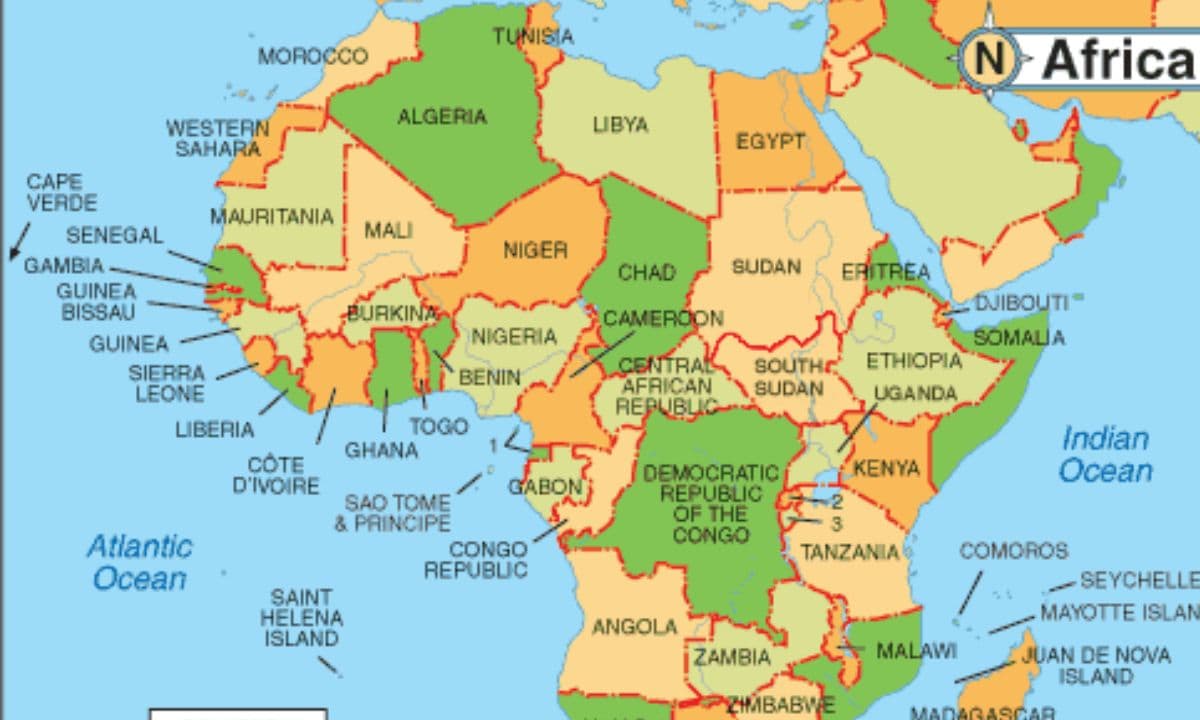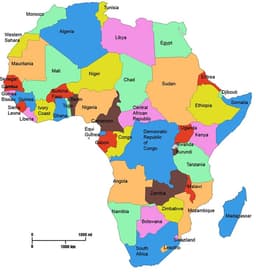Top 20 Richest Countries in Africa 2025

The ranking of the top 20 richest countries in Africa 2025 by www.glusea.com is based on Gross Domestic Product(GDP) at purchasing power parity (PPP). The figures below were obtained from the International Monetary Fund, World Bank Economic Data, and Trading Economics. Africa is one of the largest continents in the world by landmass and is also known to have a larger number of poorest countries in the world, however, there are wealthy countries in the continent of Africa. Below is the list of the top 20 richest countries in Africa
Top 20 Richest Countries in Africa
Information for writing the list of the top 20 richest countries in Africa was sourced from worldpopulationreview.com
EGYPT
Peak value of GDP (PPP): $1,391.734
Egypt richest country in the richest country in Africa. with a GDP of $249.559 billion. The origin of the GDP of Egypt is most agriculture, industry, and services. Egypt is the third-largest economy in the Arab world. Services are the most important sector of the economy and account for around 47.5 percent of total GDP
More on Richest Countries in Africa
NIGERIA
Peak value of GDP (PPP): $1,214.827
Nigeria’s gross domestic product advanced 2.0 percent year-on-year in the first quarter of 2019, easing from a 2.4 percent expansion in the previous period and below market expectations of 2.1 percent, mainly due to a steeper contraction in the country’s oil sector. GDP Annual Growth Rate in Nigeria averaged 3.83 percent from 1982 until 2019
SOUTH AFRICA
Peak value of GDP (PPP) : $813.100
The South African economy shrank an annualized 3.2 percent on quarter in the three months to March of 2019, following a 1.4 percent growth in the previous period and compared with market expectations of a 1.7 percent contraction.
ALGERIA
Peak value of GDP (PPP) 684.649
The economy of Algeria advanced 1.5 percent in the first quarter of 2019, following a downwardly revised 2.3 percent growth in the previous period. Output rose at a softer patch for construction (2.9 percent vs 8.6 percent in Q4); agriculture (2.7 percent vs 3.8 percent) and manufacturing (4.6 percent vs 4.7 percent).
More on Richest Countries in Africa
MOROCCO
Peak value of GDP (PPP) 330.381
The economy of Morocco advanced 2.8% from a year earlier in the first quarter of 2019, following a 2.9% expansion in the previous period. Output rose at slower pace for wholesale & retail trade (3.8% vs 4.5% in Q4); finance & insurance (2.5% vs 3.9%); post and telecommunications (2.3% vs 2.7%) and manufacturing (2.5% vs 3.9%).
ETHIOPIA
Peak value of GDP (PPP) 240.705
The Gross Domestic Product (GDP) in Ethiopia expanded 9.20 percent in 2018 from the previous year. GDP Annual Growth Rate in Ethiopia averaged 5.88 percent from 1981 until 2018, reaching an all time high of 13.90 percent in 1986 and a record low of -11.10 percent in 1984.
More on Richest Countries in Africa
GHANA
Peak value of GDP (PPP) 211.127
The Gross Domestic Product (GDP) in Ghana expanded 1.60 percent in the first quarter of 2019 over the previous quarter. GDP Growth Rate in Ghana averaged 1.62 percent from 2006 until 2019, reaching an all time high of 7.40 percent in the first quarter of 2011
Ghana possesses industrial minerals, hydrocarbons and precious metals. It is an emerging designated digital economy with mixed economy hybridisation and an emerging market.
ANGOLA
Peak value of GDP (PPP) 203.763
The economy of Angola shrank 0.4 percent year-on-year in the first quarter of 2019, after an upwardly revised 2.6 percent growth in the previous period. The downturn mainly reflected declines in oil extraction and refining (-6.9% vs -9.6% in Q4); manufacturing (-6.5% vs 9.2%); internal trade (-3.2% vs 24%); post & telecommunications (-6.8% vs 9.3%); finance & insurance (-4.8% vs 18.7%) and fishing (-7.4% vs -24.6%). Also, output growth weakened markedly for extraction of diamonds and other minerals (0.1% vs 1.5%) and utilities (9.9% vs 17.2%). In contrast, construction rose solidly (11.3% vs 5.7%).
KENYA
Peak value of GDP (PPP) 190.970
The Gross Domestic Product (GDP) in Kenya expanded 1.66 percent in the first quarter of 2019 over the previous quarter. GDP Growth Rate in Kenya averaged 1.34 percent from 2005 until 2019, reaching an all time high of 3.80 percent in the third quarter of 2010
More on Richest Countries in Africa
LIBYA
Peak value of GDP (PPP) 187.796
The Libyan economy depends primarily upon revenues from the oil sector, which account for over half of GDP and 97% of exports. Libya holds the largest proven oil reserves in Africa and is an important contributor to the global supply of light, sweet crude.
The Gross Domestic Product (GDP) in Libya expanded 10.90 percent in 2018 from the previous year. GDP Annual Growth Rate in Libya averaged 5.26 percent from 2000 until 2018.
Libya is one of the richest African countries in 2023.
TANZANIA
Peak value of GDP (PPP) 186.060
Tanzania’s economy advanced 6.6 percent year-on-year in the first quarter of 2019, slowing from a 7.1 percent growth in the previous period, mainly due to smaller gains in construction (13.2 percent vs 17.3 percent in Q4), manufacturing (4.8 percent vs 16.7 percent) and trade & repair (3.8 percent vs 8.0 percent).
Tanzania’s largest trading partners in 2017 for its US$5.3 billion in exports were India, Vietnam, South Africa, Switzerland, and China. Its imports totalled US$8.17 billion, with India, Switzerland, Saudi Arabia, China, and the United Arab Emirates being the biggest partners.
More on Richest Countries in Africa
SUDAN
Peak value of GDP (PPP) 177.678
The Gross Domestic Product (GDP) in Sudan expanded 4.10 percent in 2018 from the previous year. GDP Annual Growth Rate in Sudan averaged 4.24 percent from 2005 until 2018, reaching an all time high of 7.70 percent in 2006 and a record low of 1.40 percent in 2012.
More on Richest Countries in Africa
TUNISIA
Peak value of GDP (PPP) 150.834
The economy of Tunisia advanced 1.2 percent year-on-year in the second quarter of 2019, little changed from a 1.1 percent growth in the previous period. Output rebounded for agriculture & fisheries (2.8 percent vs -0.7 percent in Q1) while contracted for manufacturing (-0.8 percent vs -0.9 percent) and services (-2.6 percent vs -0.7 percent). On a quarterly basis, the GDP rose 0.5 percent, after an upwardly revised 0.2 percent advance in the previous quarte
COTE D’IVOIRE
Peak value of GDP (PPP) 117.030
The Gross Domestic Product (GDP) in Ivory Coast expanded 7.20 percent in the first quarter of 2019 over the same quarter of the previous year.
Ivory Coast has, for the region, a relatively high income per capita (US$1,662 in 2017) and plays a key role in transit trade for neighbouring landlocked countries. The country is the largest economy in the West African Economic and Monetary Union, constituting 40% of the monetary union’s total GDP. Ivory Coast is the fourth-largest exporter of general goods in sub-Saharan Africa (following South Africa, Nigeria, and Angola).
UGANDA
Peak value of GDP (PPP) 104.893
The Gross Domestic Product (GDP) in Uganda expanded 0.30 percent in the first quarter of 2019 over the previous quarter.
The country has been experiencing consistent economic growth. In fiscal year 2015–16, Uganda recorded gross domestic product growth of 4.6 percent in real terms and 11.6 percent in nominal terms. This compares to 5.0 percent real growth in fiscal year 2014–15.
The country has largely untapped reserves of both crude oil and natural gas.
CAMEROON
Peak value of GDP (PPP) 101.124
The economy of Cameroon advanced 4.2 percent year-on-year in the first quarter of 2019, following a downwardly revised 3.5 percent growth in the previous period
Cameroon’s per capita GDP (Purchasing power parity) was estimated as US$3,700 in 2017. Major export markets include the Netherlands, France, China, Belgium, Italy, Algeria, and Malaysia.
Cameroon has had a decade of strong economic performance, with GDP growing at an average of 4% per year. During the 2004–2008 period, public debt was reduced from over 60% of GDP to 10% and official reserves quadrupled to over US$3 billion.
Cameroon is part of the Bank of Central African States (of which it is the dominant economy), the Customs and Economic Union of Central Africa (UDEAC) and the Organization for the Harmonization of Business Law in Africa (OHADA). Its currency is the CFA franc
More on Richest Countries in Africa
DEMOCRATIC REPUBLIC OF CONGO
Peak value of GDP (PPP) 77.441
The Democratic Republic of the Congo (DRC), also known as Congo-Kinshasa and formerly known as Zaire, is a country in Central Africa. By land area, the DRC is the second-largest country in Africa, after Algeria, and the 11th-largest in the world. With a population of around 112 million, the Democratic Republic of the Congo is the most populous officially Francophone country in the world.
ZAMBIA
Peak value of GDP (PPP) 76.520
The Gross Domestic Product (GDP) in Zambia expanded 3.70 percent in 2018 from the previous year.
Presently, Zambia averages between $7.5 billion and $8 billion of exports annually. It totaled $9.1 billion worth of exports in 2018. In 2015, about 54.4% of Zambians lived below the recognised national poverty line, improved from 60.5% in 2010.
More on Richest Countries in Africa
SENEGAL
Peak value of GDP (PPP) 47.335
The Gross Domestic Product (GDP) in Senegal expanded 1.20 percent in the third quarter of 2018 over the previous quarter
The economy of Senegal is driven by mining, construction, tourism, fishing and agriculture, which are the main sources of employment in rural areas, despite abundant natural resources in iron, zircon, gas, gold, phosphates, and numerous oil discoveries recently.
Senegal’s economy gains most of its foreign exchange from fish, phosphates, groundnuts, tourism, and services. As one of the dominant parts of the economy, the agricultural sector of Senegal is highly vulnerable to environmental conditions, such as variations in rainfall and climate change, and changes in world commodity prices
MALI
Peak value of GDP (PPP) 44.028
The Gross Domestic Product (GDP) in Mali expanded 4.40 percent in the first quarter of 2019 over the same quarter of the previous year.
Mali’s key industry is agriculture. Cotton is the country’s largest crop export and is exported west throughout Senegal and Ivory Coast. During 2002, 620,000 tons of cotton were produced in Mali but cotton prices declined significantly in 2003.
In addition to cotton, Mali produces rice, millet, corn, vegetables, tobacco, and tree crops. Gold, livestock and agriculture amount to 80% of Mali’s exports.
Eighty percent of Malian workers are employed in agriculture. 15% of Malian workers are employed in the service sector. Seasonal variations lead to regular temporary unemployment of agricultural workers
Source: Glusea
You Might Also Like

The 10 Most Populated Countries in the World 2025
Travelling to different countries can be exciting and fun for a number of reasons. Understanding their culture, history, beliefs and religion are just to name a few. But often, the population gets overlooked, it’s something that’s not really seen to be important for most. However, for those of you that find this sort of stuff […]

Top 10 Biggest Entertainment Companies in The World 2025
Glusea brings to you the top 10 biggest Entertainment Companies in the world 2025. Several factors come in place when ranking the biggest entertainment companies in the world, These include; market capital, net revenue, revenue among others. Based on available data, Disney is the biggest entertainment company in the world by market capital. Top 10 […]

Top 10 Richest People in the World 2025 and Their net worth
Elon Musk $269 billion Jeff Bezos $168 billion Bernard Anault $164 billion Bill Gates $133 billion Larry Page $124 billion Mark Zuckerberg $124 billion Sergey Brin $119 billion Warren Buffet $117 billion Steve Ballmer $111 billion Larry Ellison $107 billion Top 10 Richest People in the World 2025: Billionaires all over the world play significant roles […]

Top 20 Richest Men in Nigeria 2025
Who are the richest men in Nigeria? Keep reading to find out here. Top 20 richest men in Nigeria 2025: Nigeria has a total of four billionaires in Africa as listed by Forbes magazine. These include; the richest man in Africa and the richest black man in the world Aliko Dangote, Globacom Chairman Mike Adenuga […]









